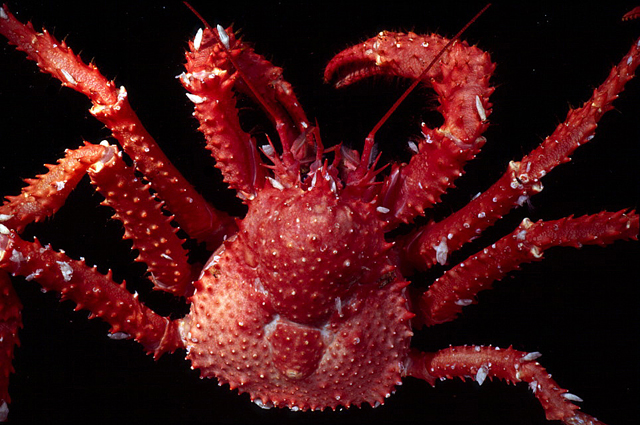Crushing blowScientists investigate invasion of shell-breaking crabs in West AntarcticaPosted November 26, 2010
The Antarctic Peninsula is one of the fastest warming spots on the planet, as indicated by the shortened duration of sea ice and the decline of animals like Adélie penguins and krill that depend on it for their ecology. Now scientists believe at least one species of king crab is slowly creeping from the deep ocean habitats onto the continental slope as the waters slowly warm, threatening marine communities that have evolved over millions of years without the pressure of shell-crushing predators. “The concern, of course, is that these crabs could have a very dramatic impact on this fairly defenseless suite of prey and alter the communities substantially,” said James McClintock Related Articles
Except for a few brief warm climatic spurts, king crabs and similar predators haven’t been in shallow-water Antarctic environments for about 40 million years, according to Richard Aronson “One of the main structuring factors in those modern bottom communities is a lack of predation by shell-cracking predators. … Those communities have a retrograde feel to them. They’re more like an anachronism — they’re more reminiscent of the Paleozoic,” said Aronson, referring to the geological era that ended about 250 million years ago. Aronson and McClintock are teaming up with British and Swedish colleagues to assess the threat of Antarctica’s first invertebrate invasion. A nine-person team will travel aboard two research vessels for nearly two months beginning at the end of November to survey the seafloor and water column for adult crabs and their larvae around Antarctica. At risk are a range of species, from ubiquitous brittle stars to bivalves to gastropods like clams and snails to starfish and sea urchins. “I don’t think there’s any question that there would be some really tasty things that they would be interested in,” McClintock said. 
Photo Credit: Richard Aronson
The unique bottom communities of Antarctica are threatened by an incipient invasion of crabs.
Since the 1950s, the average winter temperature in the region has spiked by 6 degrees centigrade, reducing the duration of sea ice in the area by three months. Over roughly the same time period, the average ocean temperature has ticked up about 1 degree centigrade. It might not seem like much of an increase, but scientists believe the freezing cold temperatures of the peninsula’s continental shelf waters have served as a barrier to the cold-blooded crabs. Deeper seawater is slightly warmer because of its saline characteristics. Aronson said scientists at the Alfred Wegener Institute “It’s just warm enough for king crabs to not have this magnesium problem on the slope, but it’s still too cool on the shelf, but as the shelf warms, we’re expecting these king crabs to come over the top and invade the bottom communities in shallower-water environments,” he noted. A Genghis Khan-esque marauding horde of crabs sweeping up the shelf may be the stuff of Hollywood, but Aronson said in geological terms, the invasion could be relatively swift. Conservatively, he said, crabs could be on the continental shelf, at depths of 1,000 meters or less, in less than half a century. “My gut feeling is that it’s going to be faster than that,” Aronson said. There is already evidence that king crabs are encroaching on the shelf, according to Sven Thatje Thatje is leading the international team on the ship-based expedition, which will take scientists from Punta Arenas, Chile, to McMurdo Station on Ross Island in Antarctica. |



For USAP Participants |
For The Public |
For Researchers and EducatorsContact UsU.S. National Science FoundationOffice of Polar Programs Geosciences Directorate 2415 Eisenhower Avenue, Suite W7100 Alexandria, VA 22314 Sign up for the NSF Office of Polar Programs newsletter and events. Feedback Form |


